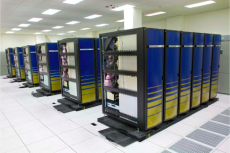Cray Delivers First Third of the Franklin XT4 System to NERSC
January 16, 2007
On Tuesday, January 16, 2007, NERSC received the first installment of its new Cray XT4 supercomputer. Although a test system had been delivered the previous fall, the delivery of 36 cabinets (including 3,336 computational dual core nodes) marks the start of the installation of the full system, which is expected to go into production this summer.
Named “Franklin” after Benjamin Franklin, America’s first scientist, the Cray XT4 will consist of more than 19,000, processor cores when fully installed. It will deliver sustained performance of at least 16 trillion calculations per second, with a theoretical peak speed of more than 100 teraflop/s. Franklin the computer was powered up for the first time on January 17, thus celebrating its birthday with Benjamin Franklin, who was born January 17, 1706.
“Franklin, the world's largest XT4 system, represents 10 times more computing power than any other NERSC system,” said Bill Kramer, NERSC’s general manager. “We are extremely pleased to be able to make such a significant addition to the resources our computational scientists use.”
Assembled and shipped from Chippewa Falls, Wisconsin, the cabinets feature a distinctive blue and gold color scheme reflecting their new home in Berkeley.
About NERSC and Berkeley Lab
The National Energy Research Scientific Computing Center (NERSC) is a U.S. Department of Energy Office of Science User Facility that serves as the primary high performance computing center for scientific research sponsored by the Office of Science. Located at Lawrence Berkeley National Laboratory, NERSC serves almost 10,000 scientists at national laboratories and universities researching a wide range of problems in climate, fusion energy, materials science, physics, chemistry, computational biology, and other disciplines. Berkeley Lab is a DOE national laboratory located in Berkeley, California. It conducts unclassified scientific research and is managed by the University of California for the U.S. Department of Energy. »Learn more about computing sciences at Berkeley Lab.








